|

BROTHER AND
SISTER, Chapter
Four
TALE OF TWO CITIES
Written by Rick Archer
|
|
The day would come when George would take
Sam Maceo's place as the new Mr. Galveston.
To understand the magnitude of George's
accomplishment, let us start with a brief
history lesson of Galveston.
Galveston
was
originally inhabited by Indians, then
pirates, then Spanish, and finally the
settlers who would become the Texans.
Following Texas
Independence from Mexico
in 1836, entrepreneurs
discovered the value of
Galveston's
world-class deep-water
seaport.
Throughout the 1800s, Galveston and Houston
were locked in bitter economic rivalry.
Galveston was the leader and it
wasn't close.
Houston had railroads, but Galveston had the
seaport. The 1900 International
Yearbook ranked Galveston the 5th port in
America.
It was an
unparalleled economic engine that created
prosperity for
everyone on the
Island. Considered
the Pearl of the Caribbean and Gulf of
Mexico,
Galveston Island was
so busy it rivaled
Hong Kong. At
the turn of the century
Galveston was now one of the richest cities in
the world on a per capita basis. Huge southern mansions lined Broadway
and grand houses were
scattered throughout the neighborhoods.
The Rich were very rich and everyone enjoyed a high
standard of living.
Cooled
by balmy ocean breezes, Galveston was an
absolute
paradise.
|
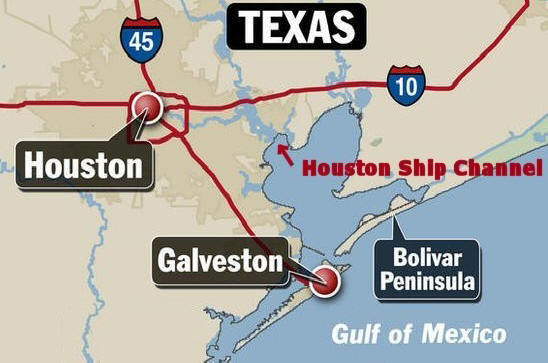 |
The 1900 census
reported Galvestonís population as 38,000. It boasted
an expansion rate that was among the highest of all Southern
cities. The gain
of nearly thirty percent from 1890 was an undeniable
indicator that Galveston was well on its way to becoming one of
the great cities of America. In 1900 the
city was ranked the second wealthiest (per capita) in the
nation. One day it all went to Hell.
|
And then the
Hurricane hit.
It was
September in 1900.
The people of Galveston never knew it was
coming.
By the time they found out,
it was too late.
There was no escape.
1 in
4 citizens died, 6,000 in all.
|
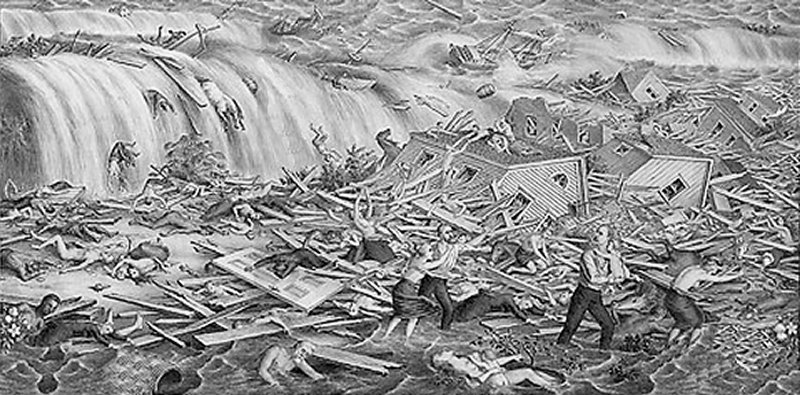 |
Oddly enough, the worst natural disaster in
American history was never given a name.
To this day, they simply call it The Great
Storm.
Ironically, Galveston had been
debating the wisdom of building a seawall
throughout the latter part of the 1800s.
"Within the last two or three years,
people have begun to think that the
islands and peninsulas along the Texas
and Louisiana Coast are unsafe places to
inhabit due to the threat of hurricane.
Galveston Island is but a waif of the
ocean, liable at any moment to be engulfed
and submerged by the self-same power
that gave it form." -- Braman's
Information about Texas, 1858
However, like many things in
life, the soothsayers were unable to capture
the attention of the townspeople until it
was too late.
The deadly Galveston hurricane still holds
the record for the
highest death total from a disaster in
America history.
At least 6,000 people
lost their lives that day, quite possibly
even more. No one will ever know the
true count. By
comparison, famous disasters such as the San
Francisco earthquake (3,000), 9-11 (3,000), Pearl Harbor (2,500), and Hurricane
Katrina (2,000) don't even come close.
|
The terrible death total can be attributed
to three factors. Based on accounts
from several books such as Isaac's
Storm, the U.S. Weather Service was
run by ignorant yahoos at the turn of the
century. Due to a dangerous
combination of arrogance and prejudice, the
U.S. Weather Service was embroiled in a
rivalry with their Cuban counterparts.
One month prior to the Great Storm, the U.S.
director prevented all Cuban weather reports
from reaching American soil. It's a
long story, but upshot is the U.S. Weather
Service figured it was smart enough to do
the job on its own. Big mistake.
The hurricane passed right over Cuba.
It was so large its distant winds crossed
Key West, the southernmost point in Florida.
Unable to access Cuban weather data, the
U.S. analysts based their decision on Key
West reports instead. When the distant
winds over Key West had a sudden drop-off in
intensity, the analysts assumed this meant
the eye of the hurricane had just begun to
curve in a northeast arc from Cuba.
After all, everyone knows that hurricanes
curve to the north. On the day the
Great Storm hit Galveston, the U.S. Weather
Service had sent out a dispatch which said
the Cuban storm was in the Atlantic Ocean.
Ironically, the Cubans got it right.
|
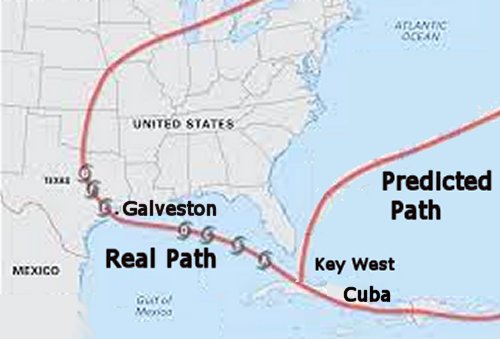 |
Ultimately it was the element of surprise
that was mainly responsible for the high
death toll. Victimized by the bogus
report, the people of
Galveston had no idea a Category Four storm
was approaching. Completely blind-sided,
the citizens had
no way to escape. Back in those days,
there was only a single narrow bridge that
connected Galveston to the mainland.
The moment the hurricane hit, that bridge
was destroyed. Now the citizens were
trapped.
The third factor was the inability to
escape. There was no
such thing as 'high land' to retreat
to. Lacking protection from the
incoming flood waters, a 15-foot storm surge
inundated the city. The wood structures were
not strong enough. Once their house fell, the people inside were goners. Structures were
flattened and stranded helpless victims in
turbulent waters. Some were lucky
enough to grab a piece of wood to stay
afloat in the raging high water, but only
the strongest avoided drowning.
The Great Storm became the defining event in
Galveston history. The surge cleared
the land of every structure on the Gulf of
Mexico side of the island. Eleven blocks
consisting of 4,000 structures were demolished. Only one
third of the city's buildings stood in the
aftermath of the
storm.
Galveston lay in ruins.
Throughout the 1800s, Galveston had been the
largest, most prosperous city in Texas.
A major center of commerce, with a
population of 38,000 at the turn of the
century, Galveston had been poised for greatness.
In the blink of an eye, that was gone.
The city had
been reduced to rubble. Overnight the
death total reduced the
population from 38,000 to 32,000.
Seeing how hopeless things were, many of the survivors moved away.
Galveston's new population count was 25,000.
|
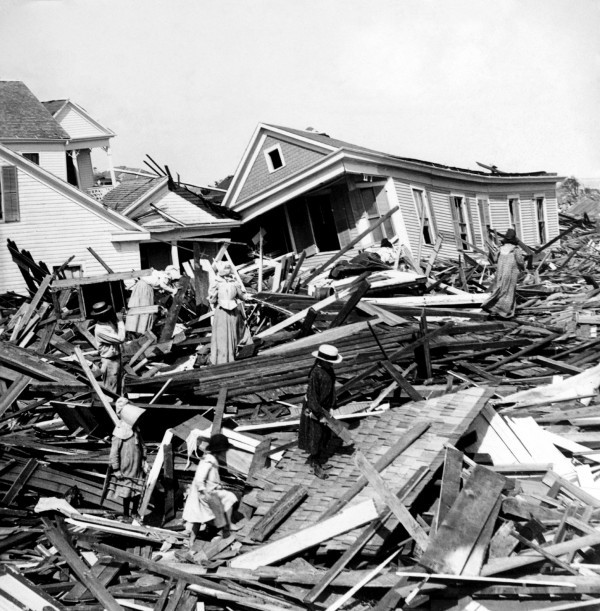 |

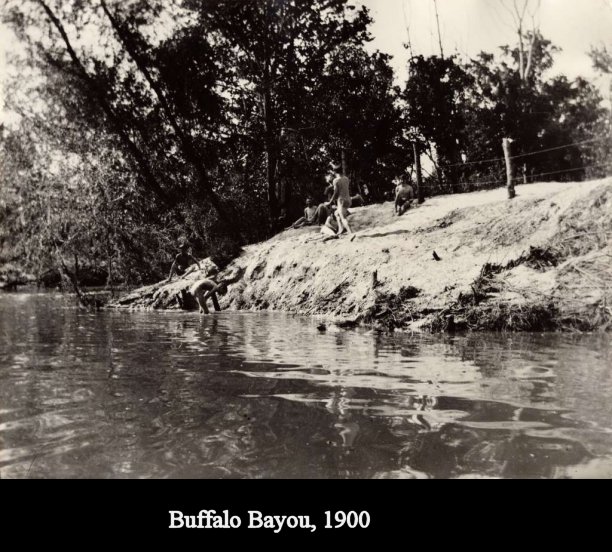 |
By every standard, Galveston was well ahead
of Houston at the turn of the century. Located
just 50 miles apart, Galveston's population was
38,000, Houston's population was 44,000.
Houston is a delta of sorts. A great deal of
East Texas and North Texas rainfall passes through Houston on its
way to the gulf. For example, if it rains hard in Dallas,
flood waters come to Houston. It would help if
Houston had a major river with a swift current.
Instead Houston has a half-dozen narrow, slow-moving bayous
which take their sweet time draining the swampy
floodplain. Due to the swampland, mosquitoes
are a serious problem as is the fearsome heat and humidity.
Whenever
it rained, the dirt roads turned to thick mud. The climate was almost
unbearable. It was so hot and muggy, no one
really wanted to live in such nasty place.
Ulysses S. Grant once said if he owned Hell
and half of Texas, he would rent out Texas and live
in Hell. Houston pretty much fit that
description.
However, Houston did have the advantage
of Buffalo Bayou, a reasonably wide, lazy waterway perfect for
Texas cotton farmers to float their crops
downstream. From there, cotton was loaded onto
trains and whisked away in every direction.
Houston was beat up by the Great Storm as well, but
survived the hurricane relatively unscathed due to
being 50 miles inland. Galveston wasn't so lucky.
By some accounts Galveston didn't even exist
anymore. Rebuilding would take a long
time.
|
Prior to the Great Storm, Houston was at
best an afterthought to the island breezes.
Houston's economy was stagnant.
Compared to Galveston's elegant homes and
state of the art buildings, Houston was a
dirty, unimpressive ramshackle town that
existed primarily as a place for railroads
to export lumber and cotton. Much of
Houston's exports went directly to Galveston
from where it was shipped to other parts of
the country. In other words, Houston
was supporting Galveston's booming
economy.
Fate can be very cruel. On September 8,
1900, the Great Storm flipped the Arrow of Destiny.
However, the hurricane was not the only
stroke of misfortune. The second bad
break came four short months later. In
January 1901, the largest oil field
discovery in world
history took place in
Beaumont, a small city in
East Texas.
The Spindletop oil discovery
would change everything. No other oil field
in the world had ever been so productive.
Now people wondered if
there was more oil to be found in Texas.
This possibility
generated a frenzy of successful oil
exploration throughout the state.
|
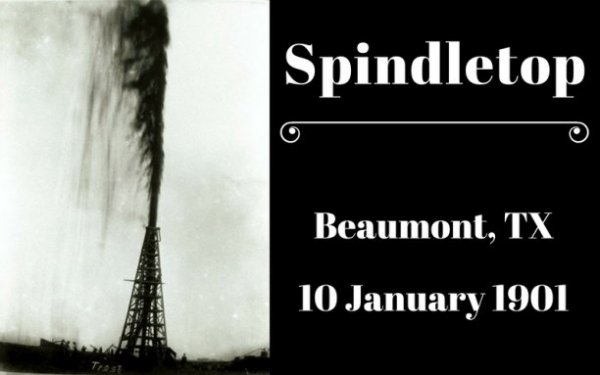 |
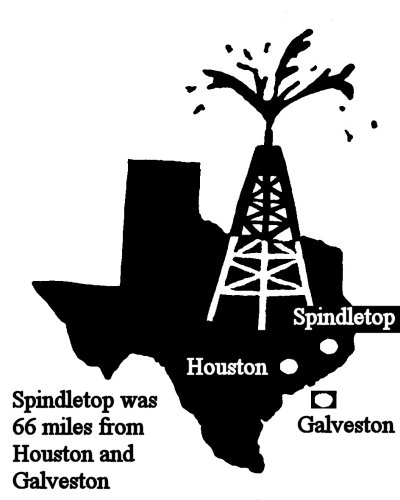 |
The ensuing economic development became
known as the
Texas Oil Boom. Thanks
to Texas, overnight the United States became
the world's leading oil producer.
Spindletop was equidistant from Houston and
Galveston. Beaumont was 66 miles
northeast of Houston and 66 miles northeast
of Galveston. One of these two cities
would be responsible for shipping
Spindletop oil
overseas and to other parts of America.
Which city would it be?? So this is a
book about Fate, correct? Well, cities
can have a Fate too and Galveston was in
serious trouble. Spindletop presented a huge opportunity at
the exact moment Galveston was unable to respond.
Although Galveston possessed the finest
natural port in the entire South, it was unable to invest in the
burgeoning oil industry. Beaumont
already had an existing rail route to Houston, so why bother
building one to Galveston? Besides, Galveston's
capital was tied up in building a seawall to
prevent future disasters. This was the same seawall
project that had been delayed for years. Not surprisingly, this time the vote
to build the seawall had passed with little opposition. Someone with a very dark
sense of humor said the people who had previously
voted against the seawall project must be dead now.
Galveston's leaders got another piece of
bad news. Following the Great Storm, they had hoped investors
would rush
to rebuild Galveston. On the
contrary, the money men stayed away in
droves. After the storm, investors were
understandably afraid of Galveston's vulnerable location.
They preferred to invest in Houston instead.
Sorry to say, Galveston's string of bad luck wasn't over. Not by a long shot.
This was just the start. No one ever
said that life was fair.
|
The man who
put the knife in Galveston's back
was Jesse H. Jones. If this
name sounds familiar, think 'Jones
Scholarship'. Yes, this was the
same man who created the
scholarship fund that caused me so
much anguish back in high school.
Jesse H. Jones was Houston's original mover
and shaker. He arrived in Houston in
1898. A builder and investor,
Jones had just begun to make his mark when
the Great Storm and Spindletop took place
back to back. Jones took careful
note of the Spindletop oil discovery.
He anticipated that the oil strike plus the
growing importance of rice crops would create a
rapid shift in the economy in Texas. Sensing
Houston was perfectly poised to take
advantage,
Jones made a recommendation that
would accommodate the explosive growth of
the Texas economy.
Jesse Jones proposed building the
Houston Ship Channel!!
Houston business leaders agreed this was a brilliant move.
Everyone knew Galveston possessed a far superior port.
It was deeper and far more
convenient to shipping in the Gulf of
Mexico. Furthermore it was right on
the Gulf while Houston was 50 miles inland. But the Texas economy could
not wait for Galveston to regroup, so the
decision to build the Houston Ship Channel was
quickly approved.
No doubt
Galveston's leaders wanted to tear
their hair out. As Houston
began its rise to prominence,
Galveston was too crippled to make a
counter-move.
Galveston officials stared glumly as
Houston dredged out Buffalo Bayou.
The engineers created an artificial
canal deep and wide enough to
serve huge oil tankers.
Ironically, the Houston Ship Channel
extended practically to the edge of
downtown Houston. Smug
executives in their tall skyscrapers
could look out and survey their
growing empire.
Poor Galveston. Crippled by the hurricane,
Galveston watched in despair as Spindletop
oil was sent by train and truck to Houston.
This momentous break shifted virtually all economic
development of the region from Galveston to Houston.
Galveston was reeling and Jesse Jones had
just supplied the kill shot.
Houston was
no longer dependent on Galveston's port. The new ship channel was not only protected
from the ocean, it was far better positioned
geographically to use the railroads and new
highways
for shipping than isolated Galveston Island.
The opening of the Ship Channel made
Houston an international seaport
overnight. Oil, rice,
and cotton came straight to Houston
shipyards and was redirected to
distant ports. Galveston's
dominant share of
Houston's economy evaporated
overnight.
Jesse Jones was not only a shrewd
anticipator of economic trends, he also
possessed
uncanny good luck and timing.
Just months before the Ship Channel was
completed in 1914, the Panama Canal opened.
Ordinarily Galveston, the superior natural
deepwater seaport, would have been poised to
take advantage. But they were still building their seawall. Houston
became the obvious next choice as the
first stop for all sea traffic to and from
the Panama Canal. The Panama
Canal should have been
Asia to Galveston.
Instead it was Asia to Houston.
Jesse Jones' lucky streak continued when
World War I broke out in 1914. Since World
War I was highly mechanized, this
created an overwhelming thirst for more oil that could only be
met from one place on earth - Houston, Texas.
The
combination of the Houston Ship Channel,
Panama Canal and World War I propelled
Houston to world prominence. Houston
was now the dominant seaport
in the South and the
nationís petrochemical leader. The
Great Storm had turned Houston
into the Energy Capital of the
world.
And what about
Galveston? No one gave it a
second thought. At the moment
it had nothing going for it.
Since Houston
is my hometown, from my point
of view, I say thank
you, Jesse Jones, for your foresight... even
if I didn't win your college scholarship.
But my heart
goes out to Galveston.
|
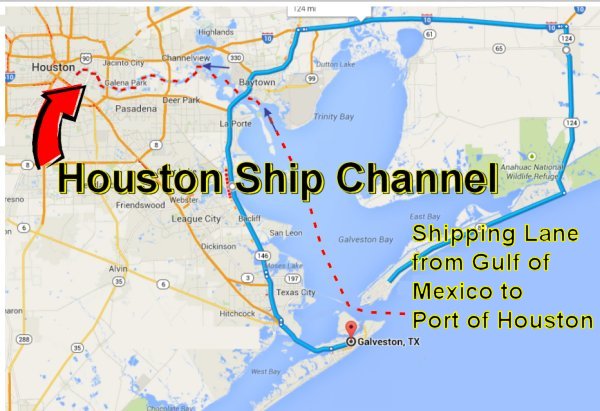
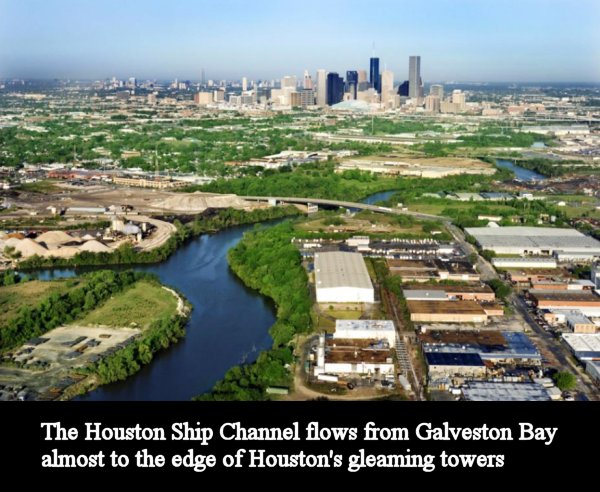
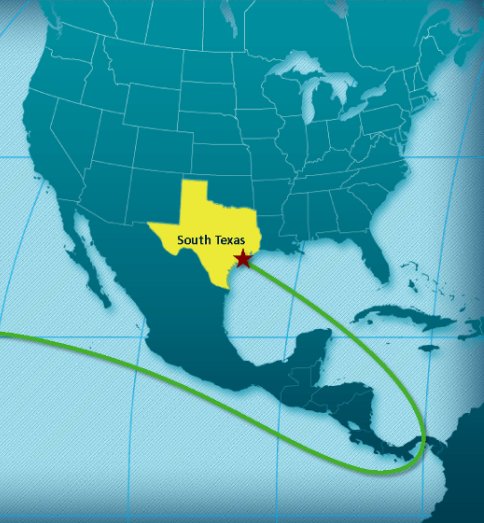 |
The seawall was
completed 1915, much too late for
Galveston's port to stage a comeback.
Houston's gain was Galveston's loss.
Houston's Ship Channel would forever more hold the upper hand.
Alarmed at the city's terrible run of bad
luck, the civic leaders decided that 'tourism'
was their best bet to make a comeback.
For starters, the new seawall helped create
a very beautiful beach right in front of the
city. So why not put a hotel there?
In 1911, the Hotel Galvez was
completed. Unfortunately, the city's
economy was still in dry dock. Despite
the beautiful hotel and the convenient
beach, there was no rush to fill the Galvez.
Strangely, the event that got Galveston
moving again was the Prohibition Era
(1920-1933). In hindsight, we now know
that a major unintended consequence of
Prohibition was the growth of urban crime
organizations... Al Capone, for example.
Into Galveston's economic vacuum came Sam
Maceo. Referred to as the 'Galveston
Godfather' and 'Mr. Galveston',
Maceo
quickly became the most important man in the
history of Galveston.
|
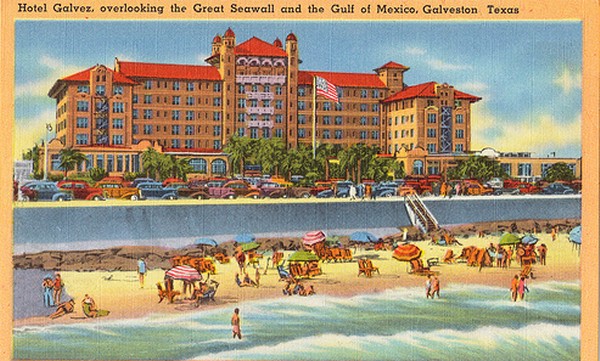 |
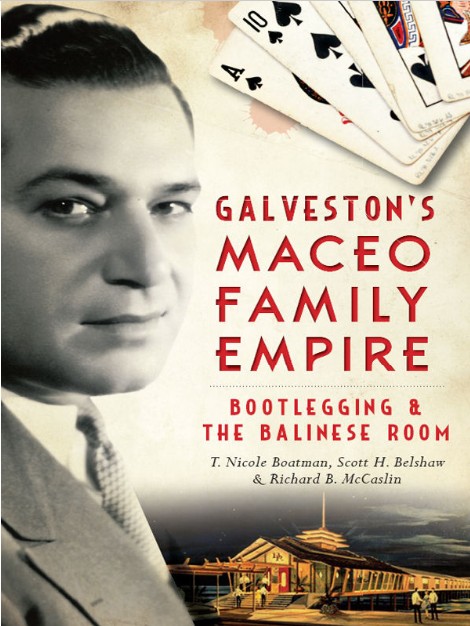 |
Sam Maceo
and his brother Rosario came to
Galveston shortly before the outbreak of
World War I. They were barbers by
trade, but soon discovered a lucrative side
business. As
Prohibition took hold, the Maceo brothers began to
smuggle in cheap wine and rum to give as gifts to
their customers.
The
booze-laden islands of Jamaica, Cuba, and Bahamas
as well as high-quality liquor from Canada
found its way to Galveston. 35 miles
southwest of the island was a rendezvous
point known as Rum Row. Bootleggers
with small, fast speedboats met schooners
outside the jurisdictional waters of the the
U.S., then carried the liquor onto secret
rendezvous points hidden along Galveston's
deserted beaches. Some of the booze
stayed in Galveston while much of it made
its way north. Seeing how interested
their customers were in the liquor, Sam and
Rosario Maceo emerged as the underworld
leaders in Galveston.
The Maceo brothers allied themselves with Beach
Gang leader Ollie Quinn and opened the
Hollywood Dinner Club,
Galveston's most
elegant night club. Sam
Maceo's smooth personality made him
the face of the nightclub. It was during
this time Maceo developed the sharp
interpersonal skills that would come in
handy when dealing with Island politicians.
In short order, Maceo learned the name of
every person of importance on the island and Galveston County.
Apparently those political skills paid off
handsomely. He persuaded law
enforcement to do the dirty work for him.
Fortuitous arrests of rival gang leaders
allowed the brothers to gain complete
control of the island's underworld without
a serious blood bath. By the late 1920s, the
upper echelon of the Galveston gangs had
gone by the wayside. With their
enemies in prison, the Maceos had garnered
complete control of the Galveston underworld.
As one
can see from this story, Sam
Maceo operated more like a clever politician than a gangster. Known as the "Velvet Glove," Maceo's smooth style and ability to
influence people was legendary. Through his vast network of
connections, Maceo wielded influence
comparable to an elected official and business leader at the same
time.
Sam
Maceo maintained relationships with
celebrities and politicians throughout Texas and the United States. Thanks in large part to his celebrity and good
deeds, law enforcement found it easier to look the other way.
|
Once Sam Maceo was in control, he
built an empire based on alcohol, gambling, prostitution, nightclubs
and first-class entertainment. Unlike the Brando character in the
Godfather, Maceo was not
known for his use of force.
Since Maceo was allowed to rule Galveston without interference, he
always preferred
to use persuasion in lieu of force.
Although his brother Rosario was known to
use violence on occasion, by and large Sam
Maceo was a benign presence who made sure there were no widespread vendettas.
Galveston had long been a hot spot for
prostitution dating back to its origins as a
pirate hangout. Legend has it
that Galveston and the State of Texas owed a large debt of gratitude to
a
prostitute named Emily Morgan. This former slave girl
would come to be known as "The Yellow Rose of
Texas" due to her mulatto
light-brown skin color.
Emily Morgan caught the eye of Generalissimo Santa Ana during
his
visit to a Galveston brothel following
his brutal victory at the Alamo.
Santa Ana was so smitten with Emily's charms, he
was unwilling to part with her. Santa Ana took Emily
with him to his campground at
nearby San Jacinto. This area was a swampland located on
the banks of the Buffalo Bayou halfway between Houston and
Galveston. The Yellow Rose distracted Santa Ana so
thoroughly that he
failed to make sure the grounds were
properly guarded.
The following
morning, the Texas army under General Sam
Houston surprised the flat-footed
Mexicans. The fight lasted just 18
minutes. In that brief time, 600
Mexican soldiers were killed and 730
captured. By contrast, only nine
Texans died.
Was it the
superior fighting ability of the Texas men or the
superior charms of the Texas women that created Texas
Independence? There is little doubt
Santa Ana wasn't the only man who let down his guard thanks
to Emily Morgan and the scarlet ladies who came along with
her.
Texas had its independence and the nearby community got its
name... Houston.
Perhaps the success of the
Yellow Rose and her friends had in disarming the Mexican army
can explain Galveston's relaxed attitude towards women of the
night. During the Maceo
Era, Galveston law enforcement more or less turned a blind eye towards prostitution. You never knew
Texas history was so titillating, did you?
|
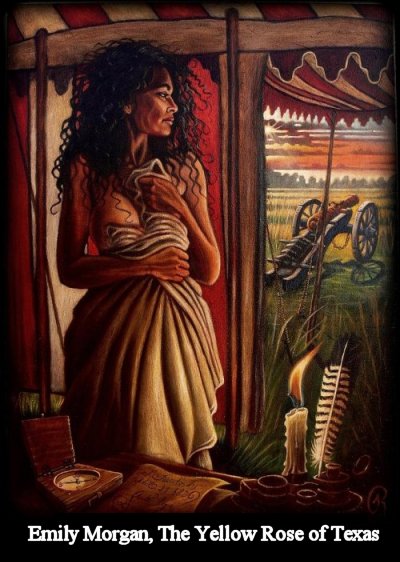 |
The benign
attitude extended to gambling and drinking as well.
Other than the occasional wink-wink raid where Maceo was
tipped off in advance, Galveston law enforcement pretty much
let Sam Maceo do whatever he wanted to do. Nor did the State of Texas
bother to interfere. For some strange reason, the rest
of the state seemed content to let Galveston
conveniently ignore the vice laws.
During this wild and crazy time, the
city became known as the 'Free
State of Galveston'. The idea was
that Galveston was so special it did not have to obey the
rules that applied to the rest of Texas. My guess
is that most Texas politicians didn't like
Prohibition any more than the next guy.
They
enjoyed having a place where they could go
to have
some fun while saving their pompous law and
order speeches for home.
Since gambling and bootleg liquor went
hand-in-hand with prostitution, the
back rooms of the popular nightclubs along the
Galveston seawall became known for
illegal activities during the Prohibition
Era. People from across
the state and nearby Louisiana flocked in to
join the fun.
In addition, all those Houston
millionaires made sure to buy a pleasure
palace on Galveston Island to accommodate
their frequent visits. In this way,
much of that new-found Houston oil money made
its way back into the Galveston economy. Sam Maceo became the talk of the town.
Thanks to the prosperity generated by Maceo's empire of decadence, the Twenties
and Thirties would become the heyday of
Galveston.
In the process, Sam Maceo turned Galveston
into the Sin City of the Gulf Coast.
|
| |
Deep in the South of Texas
Not so long ago
There on a crowded island
In the Gulf of Mexico
It didn't take too much money
Man, but it sure was nice.
You could dance all night if
you felt all right,
Drinking whiskey and throwing
dice.
And everybody knows
It was hard to leave.
And everybody knows
It was down at the Balinese.
-- Down at
the Balinese, ZZ Top
|
 |
sAM MACEO'S
BALINESE ROOM
|
When speaking of the Maceo Era, people often refer to Galveston as the
Las Vegas of the Thirties.
This phrase is highly ironic. Vegas and Galveston came to have a very
interesting connection. Because
he broke laws, Sam Maceo was considered a gangster, but at
heart he operated more like a Vegas businessman.
Over time, the Maceo brothers came to own all the
major vice-oriented businesses on the Island.
Turning his nightclubs into casinos,
Galveston was Vegas long before Vegas come
to prominence in the late 40's.
In the midst of all this sin and
debauchery, the
Balinese Room stood out as the
most famous nightclub. Built in
1942, the
Balinese was ostensibly a restaurant,
but there was a well-known casino at the
back. The casino was placed at
the very back of the long pier which
extended far into the Gulf. The pier
was so long, there was a
standing joke which claimed the waiters caught fish
to sell
during their break.
Sam Maceo used a well-known real estate
technique known as 'location location
location' to ensure his nightclub's
success. He put the Balinese right across the street
from the magnificent Hotel Galvez.
Smart move.
Sam Maceo cultivated a relationship with
William Moody, Galveston's business leader
and owner of the Hotel Galvez. Moody
and Maceo got along just fine. Thanks
to Maceo, Moody's giant hotel stayed packed
with celebrities and guests who flocked to
visit the nation's hottest resort town.
Imagine their delight to discover that every
vice known to man was open to all, a major
lure during Prohibition. Thanks to its
bad reputation, Galveston
became the
playground of the Southwest,
even bigger than New Orleans.
Though certainly no saint, Sam Maceo was
extremely civic-minded. His assistance
to charities, churches and schools generally
kept his organization from having much
trouble with the law. Other than the
occasional perfunctory pre-arranged raid,
law enforcement left him alone. Maceo endeared himself not just to William
Moody, but to all his Galveston business
friends by
sharing profits throughout the city.
In this way,
Maceo
returned prosperity to an economy still
depressed
from hurricane devastation thirty years
earlier.
No one dared upset the apple cart. Legitimate
island businesses
such as banking and hotels were able to
thrive thanks to the illegal
activities. Real estate was booming
thanks to Houston millionaires buying up
those fancy mansions along Broadway Boulevard.
Since Maceo had tacit support from the
business community, it stands to reason
the politicians were also under his spell.
Maceo's benevolence
helped considerably. During his time
as the island's dominant figure, he never
abused his power. For example, as a
rule he did not
attempt to prevent others from prospering so
long as it did not interfere with his
business interests. Thanks to
Sam Maceo, prosperity had returned to
Galveston. Maceo was the guy who
turned the lights back on. Let the
Good Times Roll.
|
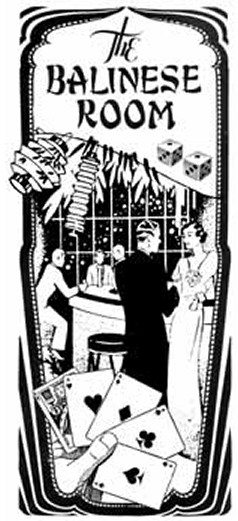 |
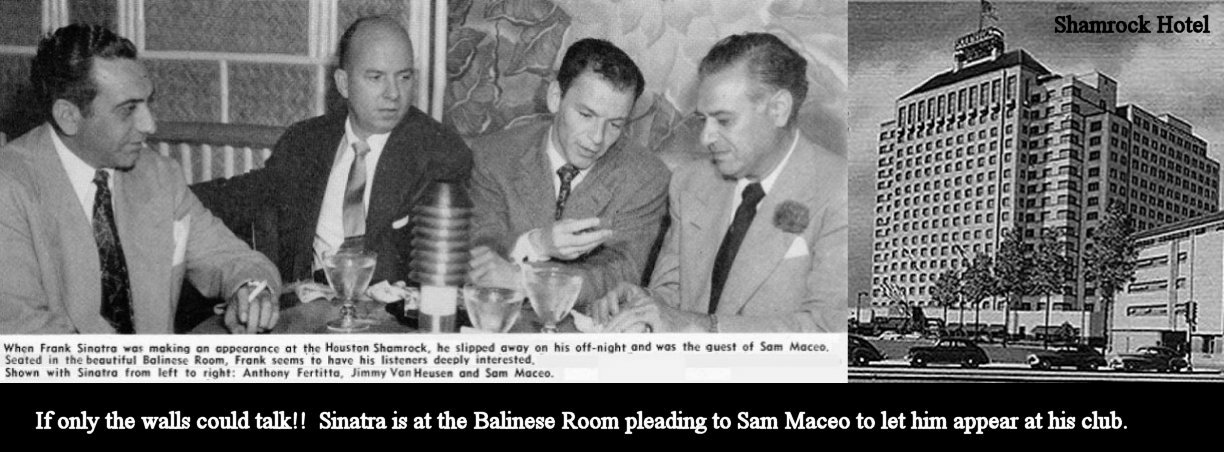 |
Rumors persist
that Sam Maceo was the inspiration for the Godfather
scene involving Vito Corleone and Johnny Fontane.
The
Balinese Room opened in January 1942 with the big bands of
Phil Harris and Val Olman. It quickly became a prime
destination for the rich and famous. Sam Maceo learned
early on how to use celebrity power to boost the appeal of
his Balinese Room. The nation's biggest stars
performed there, including Bob Hope, Spike Jones, Peggy Lee,
Vaughn Monroe, Duke Ellington, Mel Torme, Tony Bennett, and
Edgar Bergen.
Oh,
plus some guy named Frank Sinatra. It
is said that
Frank Sinatra used his mob
connections throughout the years to advance
his career. This led to an interesting tale
involving Sinatra and Sam Maceo.
Long
known as a ladies man, Sinatra could have any woman he
wanted. Then one day he met a woman who could have any
man she wanted... and did.
Due to his disastrous love affair with
notorious femme fatale Ava Gardner, Frank
Sinatra's life and career hit rock bottom
in 1950.
The publicity about
Sinatra's adultery was Strike One. Music tastes had
shifted after the World War. Strike Two. Ava Gardner
left him to chase a Spanish bull fighter. Strike
Three.
Down on his luck with
his career
in deep trouble,
Sinatra landed in Houston while trying to stage a
comeback. Sinatra convinced Houston wildcatter Glenn McCarthy
to book him into the Cork Club atop McCarthy's
magnificent Shamrock
Hotel.
One day, Sinatra
and his friend Jimmy Van Heusen drove
down to Galveston.
Van Heusen was a composer of many Sinatra hits such as 'Come Fly With
Me'. Sinatra wasted no time
pestering crime boss Sam Maceo to book him
into the Balinese Room following
his Shamrock engagement
up in Houston.
Maceo eventually did book Sinatra to sing
as the front man for the house band.
While this billing was not quite the star of yore, the breather worked
wonders. Sinatra's extended gig at the Balinese played a
large role in his comeback. Within two years, Sinatra's luck
changed.
Once he was cast in
From Here to Eternity, Sinatra won an
Oscar and was back in the game.
Although Mario Puzo's Godfather books were supposed to be
fiction, many believe those books didn't require much
imagination to write. Some say the story of how
the Godfather helped singer
Johnny Fontane in Godfather I was a thinly
disguised reference to Frank Sinatra. What they don't
say was this scene was based on Sam Maceo as well.
Things changed after World War II.
The Maceo
operation began to draw
so much heat
that Maceo was forced to transfer
his operation to Las
Vegas, a move highly reminiscent of scenes from
Godfather II.
Say what you will about Sinatra, he was
very loyal to his friends. Sinatra never forgot what
Sam Maceo had done for him. He would one day repay the
debt in a very special way.
|


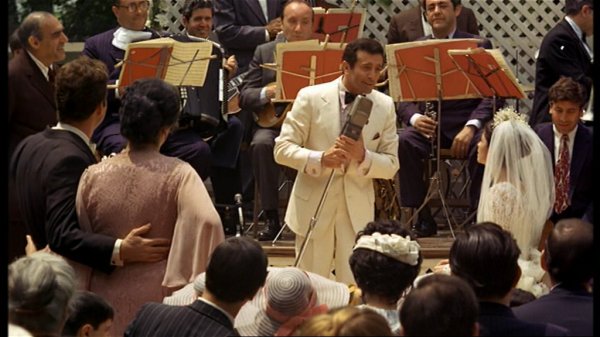 |
|
THE DOWNFALL
OF GALVESTON
|
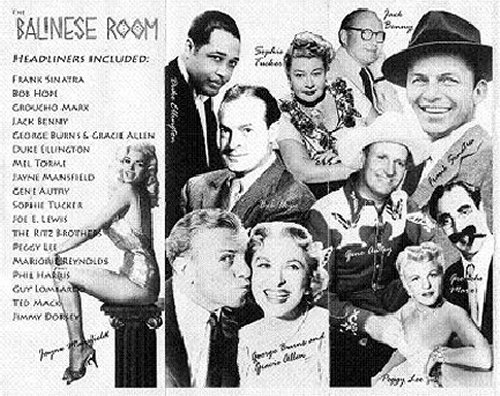 |
There probably never would have been a Vegas if Texas
law enforcement had not run Sam Maceo out of town.
Using considerable skill, Sam Maceo
made the Balinese Room famous throughout the
nation. The
impressive list of entertainers who
performed at his club underscores Maceo's substantial influence.
Given the prosperity
he created and his benign approach, Maceo
knew few enemies. This explains how he
was allowed to run vice on the island for
three decades with little opposition.
So what went wrong?
World War II didn't help things. After
Pearl Harbor, people weren't exactly in the
same mood for partying as they had once
been.
Then the Hotel Galvez across the street
became headquarters for an expanded Coast
Guard presence to patrol the Gulf of Mexico.
Tourists were forbidden to stay there and
the Balinese Room was declared 'off-limits'
for the men barracking at the Galvez.
An armed MP was posted at the front of the
Balinese to discourage military personnel
from sneaking in. As one can guess,
without the Hotel Galvez, business tapered off a bit. Still, the
Balinese remained popular enough. It
quickly regained momentum when World War II was over.
However, Maceo
noticed the Texas political climate had changed
following the war.
Feeling the heat, in the early Fifties Maceo
decided to invest in a new venture known
as Las Vegas 'just in case'.
|

For thirty years, the laws that applied to
other parts of Texas had not applied to
Galveston. However, after the war, this
open-minded attitude seemingly shifted.
Law and Order politicians from other parts
of Texas called upon the Texas Rangers to
look into the Maceo operation.
The end came in the mid-Fifties when Will
Wilson was elected as Texas Attorney General.
He had campaigned to close down Galveston's illegal casinos.
The entrance of the Texas Rangers into the
picture brought on a semi-comic cat and
mouse game. Everyone knew the casino
was operating in violation of the law and
that the clubís illegal gambling made it a
hub of mob activity. The problem was
catching them in the act.
The Rangers set up shop in a hotel near the
club and raided the casino often. But their
efforts were thwarted by the length of the
pier. Upon their arrival, the band would
play
the well-known song 'Eyes of Texas'. This alerted dealers
and waitresses at the back to start a
well-rehearsed cover-up. They were so
fast, by the time
the Rangers ran down to the tail end of the
long corridor, the evidence was gone.
Tables, cards and chips had
vanished into secret wall and floor
pockets.
The Rangers eventually found an easier way
to shut the club
down.
First they
gave up trying to catch anyone. Then,
taking a page out of the MP technique used
during the war, the Rangers sat in the casino
all
day long till it closed at night. Intimidated by the Rangersí
presence, the customers stopped coming.
The Balinese went out of business in 1957.
Sam Maceo was long gone by this
time.
As investigation
into Maceo's activities grew more serious in the late Forties, Maceo
was fed up with the interference. Frustrated by
the constant need to keep his extensive gambling activities
under wraps, Maceo turned his eyes elsewhere.
At this point Maceo decided to move his empire to Nevada.
He became a major player in a new mob venture known as 'Las Vegas'.
Maceo became the
leading investor in the
Desert Inn, a new Vegas casino which opened in 1950. At the time, the
Desert Inn was the largest and most elaborate casino resort on
the Las Vegas Strip. Sam Maceo knew just who to
call to generate action. Frank Sinatra was a loyal friend who
enjoyed returning a favor. Sinatra's
fame
helped Maceo get the Desert Inn off to a great
start. What goes around comes around.
Sam
Maceo once said that if Texas would just
legalize gambling, he could have made
Galveston bigger than Havana and Las Vegas
combined. Too bad the State of Texas
wasn't listening. Otherwise they would
have supported Maceo instead of running him
out of town. Vegas
might have still hit it big, but Galveston
was already smoking hot. If Maceo had
been allowed to run things his way, major
mob money would have gone directly to Maceo's
lucrative Galveston playground.
One can
only wonder what Galveston would be like
today if Sam Maceo had gotten his way.
Despite his best efforts, Maceo
was never able to find a way to get gambling
legalized in Texas. Galveston's loss turned into immense good
fortune for Las Vegas.
What a
shame. Look
at Las Vegas is today. Houston could have been the
next door neighbor to the largest resort
center in the country. Considering
Houston doesn't have a clue when it comes to
attracting tourism, the two cities could
have established a fabulous relationship.
Oh
well, so much for the fickle finger of Fate.
|
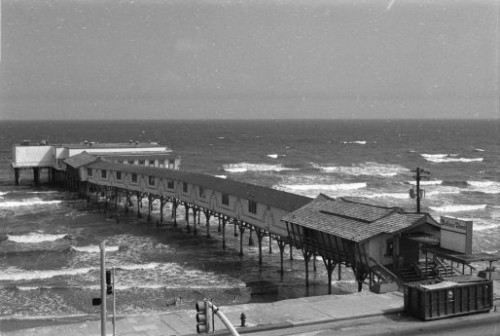

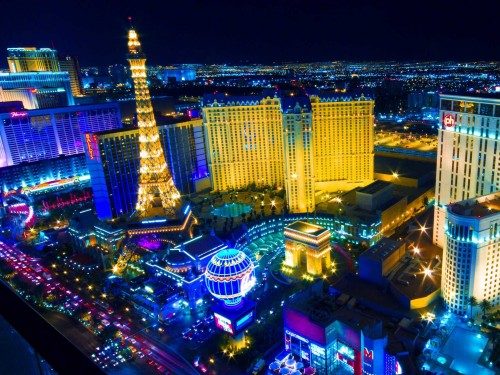 |
People say the
day Sam Maceo left town was almost as bad as the day the Great Storm
hit. The death count was missing, but the damage to
the economy was painful. Once the Texas Rangers turned out
the lights, Galveston plummeted rapidly. Without the Velvet Glove, things were never the same. Vegas became
a boom town and Galveston became a ghost town.
The closing of the
Balinese in the mid-Fifties marked the end of an era.
Prostitution was gone. Forty-seven clubs,
brothels, and vice establishments were reportedly closed
and 2,000 slot machines were destroyed. Though officials
claimed to have destroyed all the gaming equipment, that was
nonsense. Most of
the equipment had simply been shipped to Las Vegas before the authorities
ever discovered it. Either way, it didn't matter.
The Port had never bounced back and Tourism was completely
eliminated. The empty hotels were bleeding money and
put up for sale. No one bought them. Beautiful homes were put
up for sale. No one bought them.
Law enforcement
bragged that they had rid Galveston of organized crime.
What a joke. As they
say, be careful what you wish for. All along Galveston had
thought it had a serious crime problem, but now that Sam Maceo
was gone,
they learned what real crime was.
A far more dangerous criminal element
entered the vacuum created by Sam Maceo's departure. Taking
advantage of Galveston's history of lax law enforcement, street
gangs brought drugs and
armed robbery to the city. The thugs
ruled, a behavior
unheard of in the Maceo Era.
The outside forces
that killed the Golden Goose doomed Galveston to difficult
economic times in the 50s, 60s and 70s.
The city suffered the humiliation of
steep decline
into urban decay.
With little activity at
the Port and Tourism limited to
day trippers from Houston heading to
the beach, economic activity remained
anemic for thirty years.
Thirty years is a
long time.
As the years passed, the magnitude of losing Sam Maceo became
more apparent.
You don't know what you've got till its gone. The population
declined as people moved to Houston and elsewhere in
search of employment.
With a greatly diminished tax base,
services were curtailed. This led to another
serious problem. Now the beach became ugly. Seaweed
and dead fish were left to rot in the hot sun. The place
smelled and litter was not picked up regularly.
Poor police presence allowed lowlifes to make the beach unpleasant for
families to visit with their drinking and loud music.
Thugs roamed the beaches. Unchallenged by authorities,
they accosted tourists and vandalized
cars. As rumors of
poor beach conditions made their way to Houston, fewer people bothered to make the trip down.
Another blow came
when Houston's millionaires lost interest in the beautiful old
homes of Galveston. Once the area's popularity was gone,
the old homes were either left to rot or sold for pennies on the dollar.
Hundreds of magnificent Victorian style homes and
buildings were allowed to decay.
The
conditions were bad and there was not much hope the situation would
change. There was no reason whatsoever for tourists to
visit and Houston had stolen all the shipping long ago. By the time the
Seventies rolled around, Galveston was in deep trouble.
With homes crumbling before their eyes,
the last vestiges of Galveston's great past were
disappearing.
About this time, a
very bad joke was being passed around.
During the Great Storm, there was a story
about several men who were last seen
clinging to a flimsy board in the flood
waters.
The desperate men appeared to be trying to
reach the sturdy Tremont Hotel, one
of the few tall spots standing. Apparently they drowned in the deep waters just
short of reaching safety. Legend has
it that their ghosts took up residence in
the Tremont Hotel.
One day the paper
printed an off-hand
comment that
the spooky ghosts in the Tremont
Hotel had not bothered to scare anyone for quite some time.
Did anyone know where they went? The local comedians
had a field day.
Galveston was so
dead, even the dead people didn't want to stay.
|
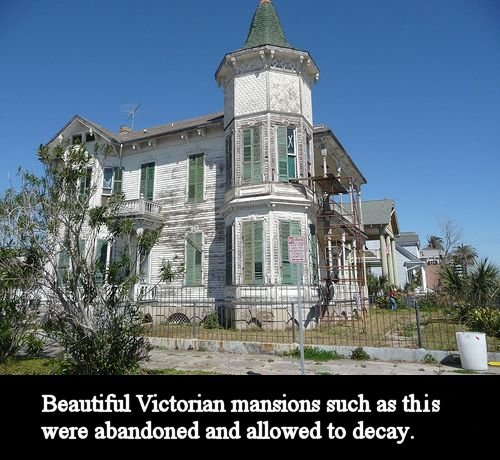

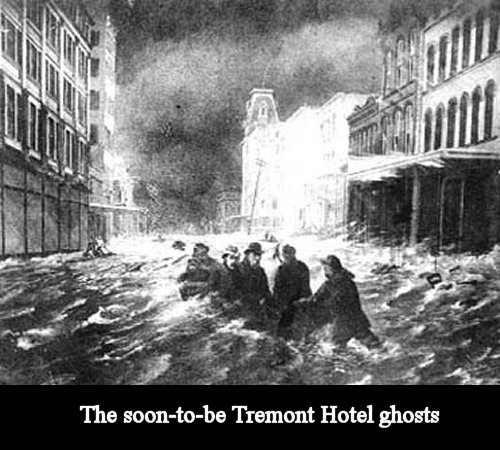
|
|
|
|